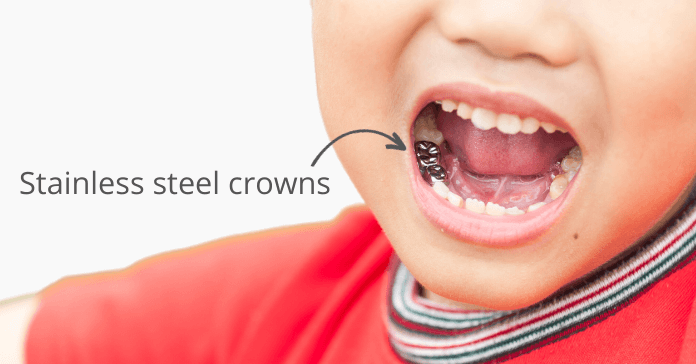As parents, we always want to ensure that our children’s teeth are healthy and taken care of. That’s why it’s important to take good care of their teeth and always be on the lookout for any dental issues that may arise. One of those issues that can arise is a problem with a tooth that requires a dental crown. If you’ve heard of dental crowns for kids but don’t know much about them, keep reading. We’ll cover everything parents need to know about crowns for kids, including what they are, why children may need them, the fitting procedure, and tips for post-procedure care.
What Are Dental Crowns for Kids?
Dental crowns, also called caps, are tooth-shaped coverings that go over a tooth to protect and strengthen it. They also restore the damaged teeth’s shape, size, and function. Dental crowns for kids can be made from stainless steel, ceramic, or composite resin. Each material has its own set of advantages and disadvantages. For example, prefabricated stainless steel crowns are the most affordable and durable option, while porcelain or ceramic crowns provide a more natural-looking result.
Why Do Kids Need Dental Crowns?
There are several reasons why your child may need a dental crown. Dental crowns can restore your child’s teeth function, making it easier for them to chew or bite food. They can also aid in speech development. Dental crowns for kids are also recommended if the child has a deep cavity or large filling in their tooth, which can weaken the tooth and make it prone to breakage.
Additionally, after pulpotomy or pulpectomy, a procedure in which the baby’s tooth pulp (nerve and blood vessels) is removed to treat baby tooth infection, your child’s pediatric dentist may recommend placing a crown on the tooth. This will help protect it from further damage and reduce the chance of infection.
Another reason is that a tooth may have been chipped or broken due to an injury or teeth grinding. A dental crown can help protect the tooth and restore its strength and function.
Uses and Benefits
- Dental crowns for kids restore the shape and size of the tooth, which is essential for proper chewing and bite alignment. This helps in maintaining good oral health and also aids in speech development.
- They are beneficial in protecting a weakened or damaged tooth from further harm. They maintain the tooth’s integrity and ensure it can perform its functions properly.
- Crowns for kids often alleviate pain or discomfort a child may experience due to a cavity or a damaged tooth, improving their overall quality of life.
- The durability of dental crowns ensures long-lasting protection.
- Dental crowns can enhance your child’s self-esteem. A damaged or discolored tooth can lead to self-consciousness. A dental crown can provide an aesthetically pleasing solution to this issue.
Types of Dental Crowns for Kids
There are a few types of crowns available for kids, including:
- Stainless steel crowns: They are the most common type. Stainless steel crowns are the most affordable option. However, prefabricated stainless steel crowns are not aesthetically pleasing.
- Zirconia crowns (ceramic): They are made from a strong and durable ceramic material (zirconium oxide). Zirconia crowns look more like natural teeth than other types of dental crowns for kids. However, they are more expensive than stainless steel crowns.
- Composite strip crowns or resin crowns: This type of crown is made from tooth-colored composite resin material. It provides a natural-looking result and is more affordable than zirconia crowns. However, they are difficult to keep clean and may not be as strong and durable as stainless steel or zirconia crowns.

How are Kids Crowns Procedure Done?
The process of placing a dental crown for kids involves several steps. It usually takes one visit to the dental office because the crowns are prefabricated. The steps include:
- Taking X-rays of the damaged tooth and the surrounding area
- Numbing the area around the affected tooth
- Make sure the affected area is clean and free from decay
- Preparing the existing (damaged) tooth so that the crown can fit securely
- Choosing the appropriate size and shape of the crown
- Fitting the crown on the tooth
- Securing the crown with dental cement or adhesive.
After the crown is placed, your child should visit their pediatric dentist regularly for routine checkups and to ensure it is still functioning properly.
Aftercare Tips
After a dental crown is placed, your child may experience some discomfort or pain. This is normal and can be managed with over-the-counter pain medication.
After the procedure, avoid hard and sticky foods, such as chewing on ice, hard candy, or nuts, as they can cause the crown to come loose.
Also, encourage your child to brush and floss regularly. Keep an eye out for any signs of infection or decay around the area where the crown was placed.
Finally, your child must visit their pediatric dentist for regular checkups to ensure their teeth are healthy.
Crowns for Kids – Conclusion
Dental crowns for kids can be a great way to protect and restore damaged teeth. They provide protection from further damage, restore the shape and size of teeth, ensure long-lasting protection, and even improve your child’s self-esteem.
When it comes to choosing the right type of crown for your child, keep in mind that stainless steel crowns are the most cost-effective option, while zirconia and composite strip crowns provide a more aesthetically pleasing result.
To ensure the crown is functioning properly, your child should visit their pediatric dentist regularly for routine checkups. With proper care and regular checkups, your child’s dental crown will last for many years to come.